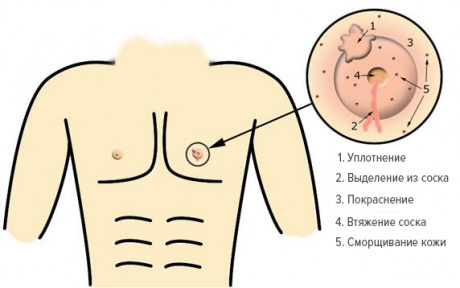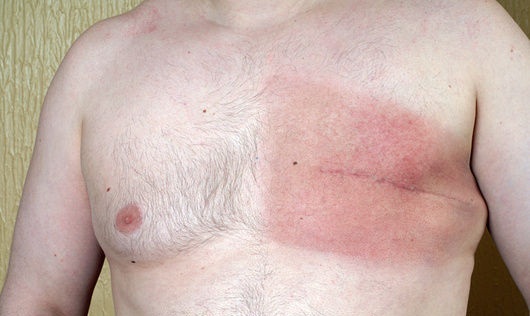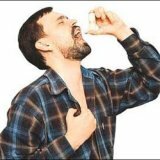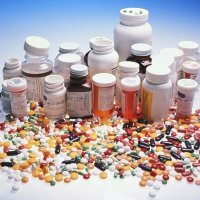Breast cancer in men
Do breast cancers occur in men? Every year in Russia, breast cancer affects about 50 thousand people. Approximately 1-1.5% of these cases occur in oncopathology in the stronger sex. Cancer in men differs little from "female" in aggressiveness, but is more often found in stages 3 and 4.Men usually get sick in middle and old age.
Content
- 1 The causes of breast cancer
- 1.1 Genetics
- 1.2 giperestrogeniey
- 1.3 Factor age
- 1.4 Obesity
- 1.5 Bad habits
- 1.6 Other factors
- 2 Symptoms of male breast cancer
- 3 disease diagnosis
- 4 forms and stages of breast cancer
- 5 Treatment of breast cancer in men
- 5.1 Surgical treatment
- 5.2 Radiation therapy
- 5.3 Chemotherapy
- 5.4 Hormone treatment
Causes of cancer developmentAnd chest
. Breast in men is represented by a small volume of undeveloped glandular tissue, fatty tissue and connective fibers. Under the influence of adverse internal and external factors in the mammary glands can appear atypical cells. Their structure and physiology are very different from the norm. Over time, such cells pass the path of progression and become increasingly malignant.
Causes of Breast Cancer in Men:
- Adverse Genetics;
- hyperestrogenia of any etiology;
- old age;
- obesity;
- bad habits( smoking, addiction to alcohol);
- repeated chest injuries;
- radial load;
- work on harmful industries, etc.
Genetics
An important factor in the occurrence of breast cancer in men is heredity. Every fifth patient with this diagnosis has a relative with a similar pathology. Scientists have proved that in the disease of a malignant breast tumor, the mutations of the BRCA2 gene play a big role.
In addition, one of the genetic diseases - Klinefelter's syndrome - leads to oncology with high probability. In patients with this pathology in the classical version, there is one additional X chromosome( 47, XXY).Such a set of genes is associated with low levels of androgens, hypoplasia of testicles, and gynecomastia. In men with superfluous X chromosome there is a relative hyperestrogenism. It is probably because of her that breast cancer develops.
Hyperestrogenia
Excess female sex steroids in men adversely affect the glandular tissue. Hyperestrogenism appears due to:
- hypogonadism( a lack of testosterone);
- liver disease;
- taking some medications, etc.
Because of the female hormones, the breast hypertrophies with the development of the true gynecomastia. Over time, atypical tissue appears atypia.
Age Factor
The older the man, the higher his risk of breast cancer. Most patients face pathology in the elderly.
Causes of high risk of disease in this group of patients:
- age-related testosterone deficiency due to andropause;
- a high prevalence of metabolic disorders( diabetes mellitus, etc.);
- accumulation of unfavorable factors. Excess weight in men is associated with hyperestrogenia. Most androgen is transformed into fatty tissue into female sex hormones. The higher the body mass index and waist volume, the more often oncology develops.
Bad habits
Alcohol has a strong negative effect on the hepatic tissue. Alcoholism naturally leads to cirrhosis. Disturbances in the liver are also manifested by activation of the conversion of androgens to estrogens in hepatocytes. In addition, some alcoholic beverages( beer) contain analogues of female sex steroids, which have a direct effect on glandular tissue.
Violate the normal hormonal balance and drugs. For example, opioids, hashish, marijuana cause persistent hyperestrogenism.
A separate risk factor is smoking. This harmful habit is associated with hypogonadism. In addition, cigarette smoke contains a huge number of chemical agents with oncogenic properties.Other factors
Chest injuries in the gland area lead to inflammation. This process is characterized by hyperemia, local accumulation of immune cells and changes in the composition of the tissue fluid. Chronic inflammation is a risk factor for oncology.
Irradiation and exposure to harmful working conditions affect the genome of cells. There are mutations in the tissues. If such atypical cells are preserved, and not destroyed by immunity, then an oncological tumor arises.
Symptoms of breast cancer in men

Fig.1 - Symptoms of breast cancer in men.
Symptoms of the disease in men can be detected very early. In the chest area, the representatives of the stronger sex do not have a large volume of soft tissues. The tumor can be noticeable by eye or palpable, even at small sizes. But, unfortunately, neither men nor doctors usually have any suspicions about this form of cancer. Therefore, with all the possibilities of early diagnosis, oncology is more often detected at a late stage.
Signs of the disease in men:
- neoplasm in the chest( more often under the areola);
- nipple retraction;
- pimpled skin of areola;
- skin ulceration;
- peeling;
- redness of the skin;
- discharge from the nipples;
- increase in axillary lymph nodes.
Tumor to the touch may be non-uniform, soldered to surrounding tissues. Usually, the neoplasm itself is painless when palpated.
Diagnosis of the disease
Cancer can be diagnosed by a doctor of any specialty. In most cases with symptoms of the disease, patients come to the therapist or surgeon. To clarify the diagnosis, a mammalogy oncologist should be examined.
Comprehensive examination includes:
- inspection;
- palpation of mammary glands and local lymph nodes;
- radiography( mammogram);
- breast ultrasound;
- tomography( CT, MRI);
- aspiration biopsy;
- study of the discharge from the nipple to atypia;
- study isolating from an ulcer on atypia;
- hormonal profile;
- oncomarkers( Sa-15-3, BRCA, CEA).
Forms and stages of breast cancer
Based on the diagnosis, an accurate diagnosis is established, including the form and stage of oncology.
The main types of cancer in men:
- protocol cancer is non-invasive;
- is a communicable cancer infiltrative;
- lobular cancer is infiltrative;
- Paget's cancer;
- edematous-infiltrative neoplasm.
All infiltrative forms of cancer are dangerous because of the tendency to germinate in surrounding tissues and metastasis.Table 1 - Stages of breast cancer.
STAGEDESCRIPTION 0 neoplasm in situ( «in situ») 1 pathological tissue volume to 2 cm, metastasis have 2 volume to 2 cm and a lymph node metastases / volume of 2-5 cm and a lymph node metastases / v 5 cm without metastases3A tumor greater than 5 cm and lymph node metastases 3B tumor with invasion into the surrounding tissue 4 Any swelling and the presence of metastases in distant organs( e.g., liver) higher stage cancer process, the worse the prognosis.Treatment of breast cancer in men
Patients with breast cancer undergo radical and conservative treatment. Most often, a man needs a complex effect on the oncological process.
The following methods are used:
- surgical operation;
- radiotherapy;
- chemotherapy treatment;
- hormone therapy.
If cancer is detected at an early stage( 0 or 1), then surgical treatment is necessary. If you can remove all glandular tissue, then no treatment is in most cases not recommended. According to the results of histology, chemotherapy is sometimes prescribed( if the tumor is highly aggressive).If part of the breast is preserved, the patient is additionally treated with radiation therapy.
Treatment 2 and stage 3 breast cancer in men combines surgery, radiation, hormone therapy and chemotherapy( if there are metastases in the lymph nodes).
If the patient is diagnosed with 4 stages, then the combination of chemotherapy and hormonal drugs comes first in the treatment regimen.
Surgery
Men preferable radical removal of all breast tissue( mastectomy).

Fig.2 - Radical removal of the mammary gland in men.
Methods of mastectomy:
- simple( removal of glandular tissue, nipple);
- radical modification( removal of glandular tissue, nipple, regional lymph nodes);
- radical( removal of glandular tissue, the nipple, regional lymph nodes, large and / or small pectoral muscle).
Organ-saving operations are recommended extremely rarely and only at the earliest stages of the process.
Radiotherapy Radiation therapy is usually given after breast-conserving surgery or curative treatment of tumor stage 2-4.
Methods of therapy:
- remote;
- internal;
- combined.
The main method of treatment is remote. It involves irradiation from the outside. The effect is on the area of the breast and other areas of the chest.
Chemotherapy
Chemotherapy drugs are prescribed for patients with aggressive tumors of any stage. In some cases, this effect must be abandoned( in case of a serious condition of the patient).Chemopreparations block the growth and reproduction of cancer cells inside the neoplasm and in metastases.
Treatment options:
- chemotherapy as the main method( at stage 3-4);
- neoadjuvant( in preparation for radical treatment);
- adjuvant( for the destruction of metastases).
Progressive chemotherapy is a targeted therapy. They have fewer side effects and a better safety profile. Successful examples of such medications are Trastuzumab, Pertuzumab, Lapatinib.
Hormonal treatment of
About 90% of mammary tumors in men are susceptible to estrogen and / or progesterone. Such neoplasms react to the use of hormonal agents.
The following preparations are used:
- antiestrogens( block receptors for estrogen), example - Tamoxifen;
- aromatase inhibitors( reduce the level of estrogen, inhibit the conversion of androgens to estrogens), an example is Arimidex;
- releasing factors of LH( inhibitors of luteinizing hormone, reduce the level of androgens), for example - Zoladex;
- synthetic progesterone derivatives( compete for receptors at the level of tumor cells), for example - Megestrol.
Doctor-endocrinologist Tsvetkova IG
Recommended for viewing:



